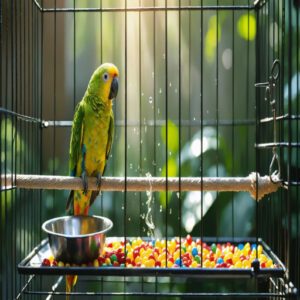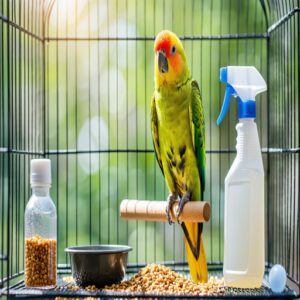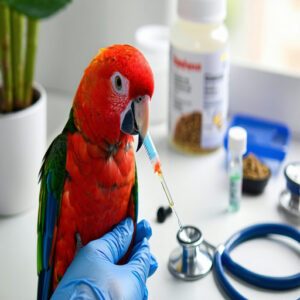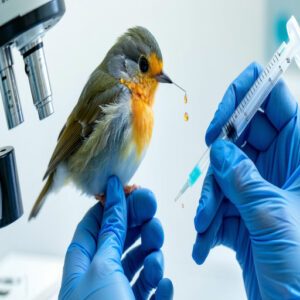This site is supported by our readers. We may earn a commission, at no cost to you, if you purchase through links.

You’ll need a vet to confirm the diagnosis using tests like bacterial cultures or imaging, ensuring the right treatment.
Antibiotics are the cornerstone, but proper doses and durations are critical—shortcuts can lead to resistant bacteria.
Prevention is your best defense: keep your bird’s environment clean, reduce stress, and offer a balanced diet to strengthen their immune system.
Think of it this way: a little effort upfront saves a lot of worry later.
Curious about safe antibiotic options?
Table Of Contents
- Key Takeaways
- Bacterial Infections in Birds
- Common Bacterial Pathogens
- Symptoms of Bacterial Diseases
- Diagnosing Bacterial Diseases
- Treating Bacterial Infections
- Antibiotic Medications
- Preventing Bacterial Infections
- Antibiotic Resistance
- Administering Antibiotics
- Responsible Antibiotic Use
- Frequently Asked Questions (FAQs)
- How do you treat a bacterial infection in a pet bird?
- What is the best treatment for throat infection?
- Can bacterial infections in birds be treated with antibiotics?
- How do you treat a bacterial infection in a parrot?
- How do you treat a fungus in a bird?
- What are the different types of antibiotics used for bird infections?
- Which antibiotic is best for birds?
- What medicine treats bird infections?
- Can birds recover from an infection?
- What are five common symptoms of a bacterial infection?
- Conclusion
Key Takeaways
- Keep your bird’s environment clean, reduce stress, and ensure a balanced diet to prevent bacterial infections.
- Recognize symptoms like lethargy, weight loss, or respiratory issues early, and consult a vet for proper diagnosis and treatment.
- Always follow a vet’s guidance when using antibiotics to avoid misuse and resistance, ensuring your bird’s effective management of infections through regular veterinary check-ups and health monitoring for early detection.
- Regular veterinary check-ups and health monitoring are essential for early detection and effective management of infections.
Bacterial Infections in Birds
Bacterial infections in birds can develop quickly, often due to stress, poor hygiene, or underlying health issues.
Recognizing the signs early and addressing environmental factors are essential to protect your bird’s health.
Causes of Bacterial Infections
Bacterial infections in birds often sneak in when hygiene slips or stress takes a toll.
Some birds carry genetic predispositions, making them more vulnerable under specific triggers.
Environmental factors or immune suppression can tip the scale.
- Stress factors and poor hygiene create high-risk conditions.
- Genetic predisposition can turn dormant carriers into active cases.
- Environmental triggers weaken their defenses.
Symptoms of Bacterial Infections
When you notice your bird acting off—like it’s lethargic, losing weight, or refusing food—it might signal a bacterial infection.
Common symptoms include respiratory issues such as wheezing or nasal discharge, digestive problems like diarrhea, and other disease indicators such as tremors.
Recognizing these bird health signs early can help address avian sickness before it worsens, and always watch for infection warning signs.
Diagnosis of Bacterial Infections
To pinpoint avian bacterial infections, rely on diagnostic tools like bacterial testing, lab analysis, and medical imaging.
While bacterial infections are a concern, avian fungal infections also pose a significant threat to bird health.
Watching for infection signs is essential, but a proper diagnosis often needs tissue cultures or cytologic exams.
These steps help choose the right bacterial infection treatment, ensuring success in treating bird infections.
Early detection makes avian bacterial infections easier to manage and improves bird infection treatment outcomes.
Common Bacterial Pathogens
When tackling bacterial infections in birds, understanding common pathogen types helps you better manage their health.
Birds can carry bacteria without showing symptoms, making bacteria transmission sneaky and hard to spot.
These bacterial strains often cause serious avian bacterial diseases if left unchecked.
Gram-negative bacteria like Klebsiella, Pseudomonas, and E. coli are frequently identified in pet birds, according to this helpful resource.
Here are some major culprits:
- Escherichia coli – Often leads to colibacillosis and swollen head syndrome.
- Chlamydophila psittaci – Known for triggering chlamydiosis, or "parrot fever".
- Staphylococcus species – Causes staphylococcosis and leg infections.
- Mycoplasma gallisepticum – A major player in respiratory bird diseases and poor growth.
- Pasteurella multocida – Leads to fowl cholera and systemic illness.
Infection control starts with vigilance and proper bacterial infection treatment to keep your feathered friends safe.
Symptoms of Bacterial Diseases
You’ll notice bacterial diseases in birds through changes like reduced appetite, weight loss, or unusual behaviors.
These symptoms often depend on the infection’s location, affecting the respiratory system, digestive tract, or even the nervous system.
Respiratory Infections
Respiratory infections in birds often appear as coughing, wheezing, or nasal discharge.
Breathing issues may escalate, signaling airway disease or avian pneumonia.
Ignoring these signs risks lung damage or tracheal problems.
For immediate assistance, review this avian respiratory infection first aid guide.
Early treatment is key.
| Possible Cause |
|---|
| Nasal discharge |
Gastrointestinal Infections
If your bird’s eating habits change or droppings look watery or oddly colored, you might be staring at a gastrointestinal infection.
Stomach infections wreak havoc on bird gut health, causing avian diarrhea and digestive issues.
Intestinal bacteria can upset their fragile system.
Prioritizing bird health care and fast antibiotic therapy guarantees treating avian infections effectively while protecting their overall well-being.
Nervous System Infections
While gut troubles can be alarming, nervous system infections take it a step further with symptoms like tremors, Avian Seizures, or loss of coordination.
It might stem from bacterial infections impacting the brain or spinal cord.
Watch for these signs:
- Sudden balance issues or falls.
- Twitching or uncontrolled movements.
- Drastic behavioral changes.
- Seizures indicating nerve cell death.
Diagnosing Bacterial Diseases
When diagnosing bacterial diseases in birds, you’ll need to closely observe clinical signs like changes in appetite, behavior, or physical condition.
Laboratory tests, including cytologic examinations and tissue cultures, are essential to identify the specific bacteria and guarantee accurate treatment.
Clinical Signs
Sometimes it’s the small things that give bacterial infection birds away—like a shift in bird behavior or unexpected physical symptoms.
Recognizing disease indicators, such as lethargy or unusual droppings, is essential for bird health management.
Health monitoring helps spot these clues early.
Use this table for guidance:
| Action to Take |
|---|
| Poor appetite |
Cytologic Examination
A key step in diagnosing bacterial infection birds face is Cytologic Examination.
This involves cell sampling from affected areas using swab techniques.
Under microscope analysis, veterinarians examine cells for abnormalities linked to bird bacterial diseases.
Tissue testing and precise lab procedures reveal bacterial patterns, aiding in treating bird diseases.
It’s a cornerstone of bird infection control before starting antibiotics for birds with a method based on bacterial infection.
Culture of Tissue Samples
After examining cells under a microscope, the next step is tissue sampling for bacterial isolation.
Laboratory tests, like microbial analysis, use sample preparation to identify bacteria causing infections in birds.
A microbiology laboratory processes these samples to pinpoint the culprit behind bird bacterial diseases.
These tests guide bacterial disease treatment and guarantee the right antimicrobial therapy is chosen for effective care.
Treating Bacterial Infections
You can treat bacterial infections in birds effectively by using the right antibiotics under veterinary guidance.
It’s essential to follow proper dosages and treatment durations to guarantee the infection is fully cleared and prevent potential complications.
Antibiotic Therapy
Antibiotic therapy is key to managing bacterial infections in birds, targeting specific bacterial strains for effective treatment.
The right approach improves bird health while avoiding antibiotic resistance.
Poor hygiene and stress can increase infection risk, according to avian skin infection experts.
Common antibiotic types used include:
- Fluoroquinolones: Potent against gram-negative bacteria.
- Macrolides: Treat respiratory infections.
- Sulfonamides: Broad-spectrum solutions.
Always guarantee medication safety under veterinary supervision to maximize treatment efficacy and protect your bird’s health.
Dosage and Administration
Getting the right bird antibiotics means nailing dose calculation based on weight and infection type.
Follow strict dosage guidelines as improper treatment plans can lead to dangerous antibiotic resistance.
Avian viral diseases like psittacine beak and feather disease require different treatment approaches than bacterial infections.
For medication administration, options include oral (via water/food), injections, or topical routes.
Timing matters—missing a dose disrupts recovery.
Always consider potential drug interactions and consult a vet.
Duration of Treatment
How long should bird antibiotics be used?
Treatment duration depends on the type and severity of the bird bacterial infection.
A typical medication cycle lasts weeks or even months to guarantee infection clearance.
Never shorten the therapy duration, as incomplete antibiotic use may cause resistance or relapse.
Follow veterinary advice on dosage guidelines to support full recovery during this critical period.
Antibiotic Medications
You’ll find that antibiotic medications are essential for treating bacterial infections in birds, but choosing the right one can be tricky without proper guidance.
Each class of antibiotics, such as fluoroquinolones, macrolides, and sulfonamides, targets specific bacteria and requires careful use to guarantee your bird’s safety and recovery.
Fluoroquinolones
Fluoroquinolones, like Enrofloxacin, are considered a powerhouse in avian medicine for tackling bacterial infections.
These antibiotics target stubborn bacterial strains, protecting birds from serious illnesses.
Quinolone therapy is often used when first-line medications fail, but overuse risks Fluoroquinolone Resistance.
Maintaining proper dosing and veterinary supervision maintains antibiotic efficacy, safeguarding your bird’s health while keeping bacterial infections under control.
The use of avian fluoroquinolone antibiotics requires careful consideration to avoid resistance and guarantee effective treatment.
Macrolides
Macrolides, like doxycycline, are powerful antibiotics for bird treatment, especially for respiratory and gastrointestinal infections.
They tackle bacterial infections by stopping protein production in bacteria.
Macrolide benefits include precise bacterial targets, minimizing harm to good bacteria, but improper use can fuel antibiotic resistance.
Always follow veterinary advice for macrolide dosage and duration to confirm effective treatment of avian diseases.
The use of bird antibiotic macrolides is a key aspect of treating bacterial infections in birds, and understanding their application is essential for successful treatment outcomes.
Sulfonamides
Sulfonamides are versatile antibiotics for treating bacterial infections in birds, but they require careful use to achieve better outcomes.
These medications work best for respiratory and gastrointestinal issues.
Follow these tips for safe use:
- Monitor dosage carefully to prevent side effects.
- Check for drug interactions with other treatments.
- Address bacterial resistance risks by consulting a vet.
- Prioritize medication safety in administration.
- Track treatment outcomes to gauge success.
When selecting antibiotics, understanding bird antibiotics sulfonamides is vital for effective treatment plans.
Preventing Bacterial Infections
You can prevent bacterial infections in birds by focusing on proper hygiene, regular veterinary check-ups, and a clean, stress-free living environment.
Simple steps like disinfecting cages, providing a balanced diet, and monitoring for early signs of illness can make a significant difference in your bird’s health.
Regular Veterinary Check-ups
Think of regular exams as tune-ups for your pet bird.
Veterinary care guarantees early detection of bacterial diseases before they spiral into bigger problems.
A comprehensive checklist can help prepare you for these important visits.
Regular bird health checks can spot issues you might overlook, like subtle weight loss or odd behavior, and preventive measures in avian health care save stress and money compared to costly antibiotic treatment.
Don’t skip those visits, as they are crucial for the early detection of diseases and ensuring your pet bird receives necessary veterinary care.
Balanced Diet
Your bird’s nutrient intake is key to preventing infections.
Offer food variety, like fresh produce and healthy snacks, to support immune health.
Consider dietary supplements for gaps in bird nutrition, but only under veterinary guidance.
Balanced diets build resilience, directly boosting avian health care.
Remember, what your bird eats impacts not just pet bird health but overall bird health and hygiene.
Clean Environment
A clean environment is your bird’s first line of defense.
Focus on strict hygiene practices like cage cleaning and regular sanitation, use proper disinfection methods for surfaces, and guarantee water purification to prevent contamination.
Maintain good air quality by reducing dust and allergens, and prioritize bird hygiene to minimize exposure to harmful bacteria and keep your feathered friend healthy and thriving.
Antibiotic Resistance
When antibiotics are overused or misused, bacteria can adapt and become resistant, making treatments less effective.
It’s imperative to recognize this growing issue and take steps to prevent resistance while making certain your bird receives proper care.
Causes of Resistance
Resistance takes root when antibiotic overuse and misuse collide with bacterial mutation, genetic factors, and human error.
Environmental pressures, like contaminated habitats or improper waste management, amplify the problem.
Birds exposed to unnecessary antibiotics risk antimicrobial resistance, making future infections harder to treat.
Prioritize responsible antibiotic use and cleaner environments to minimize resistance and safeguard both your birds and wider ecosystems.
Consequences of Resistance
Antimicrobial resistance can turn routine treatments into uphill battles.
Resistance patterns from bacterial mutation or antibiotic misuse lead to antibiotic failure, complicating treatment outcomes.
Public health risks also rise, as resistant bacteria may jump from birds to humans.
Without responsible antibiotic use, even sensitivity testing or bacterial culture might fail to secure effective treatments, leaving devastating consequences for both birds and people, due to antimicrobial resistance.
Prevention Strategies
Keeping bird hygiene of the highest standard, managing stress, and planning proper nutrition are your frontline defenses against bacterial infections.
Alongside environmental control and health monitoring, focus on biosecurity—quarantining new arrivals reduces risks substantially.
Bird disease prevention thrives on these habits while minimizing antibiotic misuse, which protects your flock and sidesteps the growing worry of resistant bacteria in avian bacteriology.
Administering Antibiotics
When you’re administering antibiotics to birds, it’s vital to follow your veterinarian’s exact instructions to guarantee proper treatment and avoid complications.
Whether given orally, through injection, or topically, each method requires care and precision for the best outcomes, and following these instructions ensures the best outcomes.
Oral Administration
Giving antibiotics like doxycycline or amoxicillin orally to birds requires precision to avoid dosing errors and guarantee medication compliance.
Liquid formulations often work best, especially for wary birds, though crushing tablets may help if mixed into soft foods.
Successful bird disease management often hinges on clever feeding techniques, as sneaky gram-negative bacteria won’t wait while you outwit a ravenous parrot.
Injection Administration
When oral methods aren’t enough, injections can save the day in bird disease management.
Proper bird restraint guarantees precision during administration, and use the correct injection sites and observe needle safety at all times.
Precise dose calculation is key, especially for antibiotics like doxycycline, amoxicillin, or enrofloxacin.
Mastering injection technique safeguards your bird’s health and speeds recovery.
Topical Administration
When antibiotics need direct application, topical administration works wonders.
From skin applications and wound care to precise use like eye drops or beak treatment, this method targets issues fast.
Want healthier feathers? Try feather sprays treated with antibiotics.
Follow strict antibiotic guidelines to tackle gramnegative and grampositive bacteria—and remember, medications like doxycycline require care.
Simple bird care tips keep infections at bay!
Responsible Antibiotic Use
You play a vital role in using antibiotics responsibly by following your veterinarian’s guidance and never skipping recommended doses.
Misusing antibiotics can harm your bird’s health and contribute to antibiotic resistance, making future treatments less effective.
Importance of Veterinary Guidance
In the context of bird health, professional guidance is everything.
Veterinary care handles bacterial infections with precision, from avian mycobacteriosis to everyday issues.
Skip guesswork—expert advice tailors antibiotic guidelines and treatment plans.
Trust medical supervision to keep your bird thriving.
Proper veterinary medicine isn’t overkill; it’s the cornerstone of responsible bird care tips that prevent trouble down the road.
Monitoring for Side Effects
Noticing side effects early can make all the difference in your bird’s recovery.
Watch for these signs of trouble:
- Adverse Reactions – Look out for diarrhea, breathing difficulty, or unusual Bird Behavior.
- Toxicity Signs – Weight loss, dehydration, or depression signal health risks.
- Medication Errors – Double-check antibiotic use to avoid harming your bird while minimizing resistance.
The instructions emphasize the importance of early detection of potential health issues in birds, highlighting key signs such as Adverse Reactions, Toxicity Signs, and Medication Errors to ensure timely intervention and proper care.
Avoiding Overuse and Misuse
While monitoring for side effects, remember that overuse or misuse of antibiotics risks bacterial resistance.
Safe dosing and following treatment guidelines are key to antibiotic stewardship.
Medication errors, like giving antibiotics for non-bacterial infections, worsen the problem.
Judicious antibiotic use minimizes resistance, ensuring future treatments remain effective.
Protect your bird—and others—by avoiding unnecessary medications, especially in cases like avian tuberculosis, which is crucial for maintaining judicious antibiotic use.
Frequently Asked Questions (FAQs)
How do you treat a bacterial infection in a pet bird?
Start treatment with a vet visit for a diagnosis and antibiotics prescription.
Follow dosing instructions closely, and maintain a clean cage.
Minimize stress, and monitor recovery.
Avoid over-the-counter remedies, as they can worsen the infection.
What is the best treatment for throat infection?
Treat a throat infection with prescribed antibiotics after a vet confirms the cause.
Maintain their hydration, offer soft foods, and create a stress-free environment.
Clean surroundings regularly to prevent reinfection and promote recovery.
Can bacterial infections in birds be treated with antibiotics?
Think of antibiotics like a double-edged sword: they treat bacterial infections effectively, but only when prescribed by a vet.
Misusing them can harm your bird’s health and contribute to antibiotic resistance.
Always consult a professional.
How do you treat a bacterial infection in a parrot?
If your parrot shows symptoms of a bacterial infection, visit an avian vet for diagnosis.
Treatment typically involves antibiotics like doxycycline, prescribed specifically for your bird’s needs.
Follow dosage instructions carefully to guarantee recovery.
How do you treat a fungus in a bird?
Treating a fungus in birds is like rooting out a weed.
This process involves antifungal medications, like itraconazole or fluconazole, prescribed by your vet, which target the infection.
Combine this with improved hygiene and reduced stress for effective recovery.
What are the different types of antibiotics used for bird infections?
You’ve got several options: fluoroquinolones for tough infections, tetracyclines for broad use, macrolides for respiratory issues, sulfonamides for varied bacteria, and aminoglycosides for Gram-negative bugs.
Always follow your vet’s advice for effective treatment.
Which antibiotic is best for birds?
The best antibiotic for birds depends on the infection type and bacteria involved.
Doxycycline works wonders for chlamydiosis, while broad-spectrum antibiotics like enrofloxacin or amoxicillin are often prescribed for general bacterial infections.
Always consult a vet.
What medicine treats bird infections?
When infections strike, doxycycline, enrofloxacin, or amoxicillin are common go-to medicines for birds, depending on the cause.
Always consult a vet to confirm you’re using the right antibiotic and dosage for safety and results.
Can birds recover from an infection?
Yes, birds can recover from an infection with proper care, including timely diagnosis, appropriate antibiotics, and a healthy environment.
Supporting their immune system with good nutrition and reducing stress makes a huge difference, utilizing good nutrition.
What are five common symptoms of a bacterial infection?
You might spot symptoms like appetite loss, diarrhea, weight loss, breathing troubles, or unusual tremors.
These signs are your bird’s way of waving a red flag – don’t ignore them; check with your vet.
Conclusion
Think of your bird’s health like a garden—nurture it carefully, and it thrives; neglect it, and problems grow.
Treating bacterial infections in birds requires early recognition, accurate diagnosis, and proper antibiotic use guided by a vet.
Prevention is your strongest tool: maintain a clean environment, reduce stress, and provide a balanced diet.
Responsible antibiotic use resolves infections and also prevents resistance, with diligence, you’ll keep your feathered friend healthy and chirping happily.
- https://pmc.ncbi.nlm.nih.gov/articles/PMC10064437/
- https://www.merckvetmanual.com/exotic-and-laboratory-animals/pet-birds/bacterial-diseases-of-pet-birds
- https://my.clevelandclinic.org/health/diseases/25023-psittacosis
- https://www.petmd.com/bird/conditions/parasitic/c_bd_Bacterial_Diseases
- https://www.wedgewood.com/blog/common-bacterial-and-fungal-skin-infections-in-birds/

















